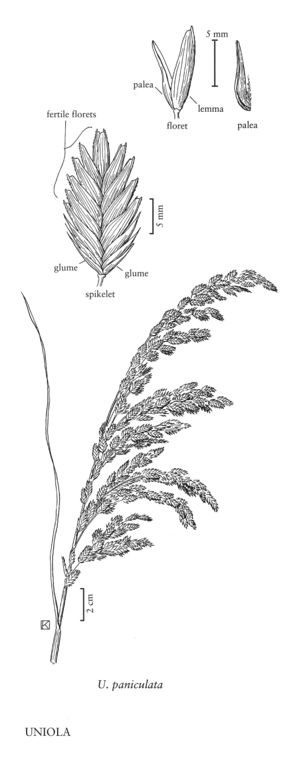| Taxon | Illustrator ⠉ | |
|---|---|---|
 | Uniola paniculata | Karen Klitz Linda A. Vorobik |
Plants perennial; rhizomatous or stoloniferous. Culms to 2.5 m, erect, glabrous, unbranched. Ligules of hairs; blades flat, becoming involute when dry, margins scabrous, tapering to an attenuate apex. Inflorescences terminal, simple panicles, exceeding the leaves; disarticulation below the glumes. Spikelets 8-50 mm long, 6-16 mm wide, ovate-elliptical to ovate-triangular, strongly laterally compressed, with 3-34 florets, lowest 2-8 florets sterile, remaining floret (s) bisexual. Glumes subequal, shorter than the adjacent lemmas, midveins keeled, serrate to serrulate, apices unawned; lemmas 3-9-veined, midveins keeled, serrate to serrulate, apices somewhat blunt to acute or mucronate, unawned; paleas, if present, from slightly shorter than to exceeding the lemmas, 2-keeled, keels winged, serrulate or ciliate; anthers 3; ovary glabrous; styles 1, with 2 style-branches. Caryopses linear; embryos less than 1/2 as long as the caryopses. x = 10.
Distribution
Md., Miss., Tex., La., Del., Ala., N.C., S.C., Va., Ga., Fla.
Discussion
Uniola has two species, both of which grow on coastal sand dunes. There is one species native to the Flora region; the second, U. pittieri Hack., extends from northern Mexico to Ecuador, primarily along the Pacific coast. The genus used to be interpreted as including Chasmanthium, a genus that is now included in the Centothecoideae.
Selected References
Lower Taxa
"decumbent" is not a number.